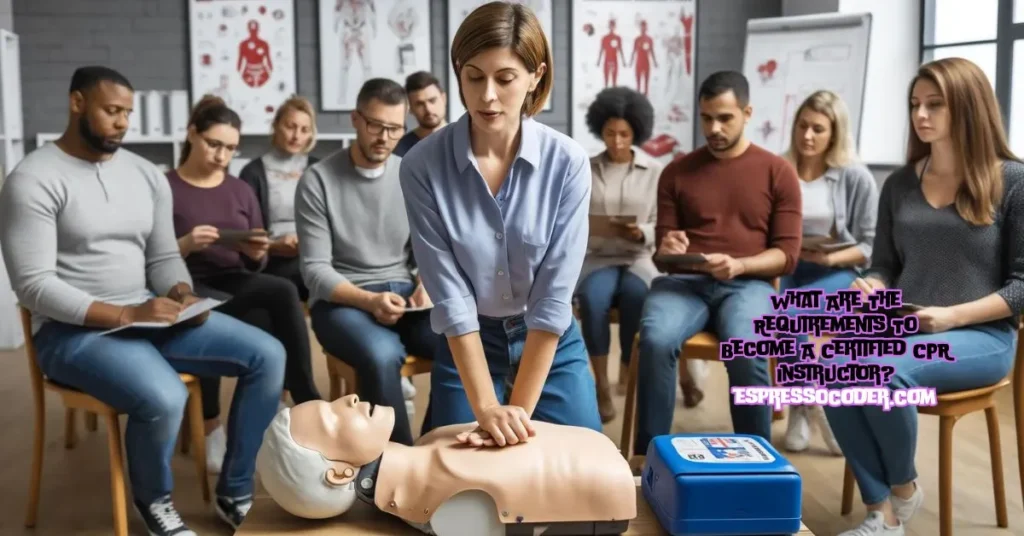Being a Certified CPR instructor is a rewarding career. It allows you to provide the knowledge of CPR and give proper training to people, thereby contributing to creating a safer society. The more people in a community know how to properly administer CPR, the better the chances of the community becoming more resilient. This also helps reduce the burden on medical professionals, as people become empowered to intervene with a first response.
To become a CPR instructor, you need a strong background in first aid and CPR. If you are passionate about teaching CPR and first aid, you can apply for a CPR instructor certification from a reputed institution.
The prerequisite to getting your CPR instructor certification is becoming an expert in these fields along with adequate experience in public speaking or teaching. You must also be adept at communicating with others, work well under pressure, show compassion and patience toward others and be able to develop different teaching methodologies.
Explore the following steps to become a certified CPR instructor:
Contents
What does a CPR instructor do?
Attending a CPR instructor certification program is a great way to start your emergency preparedness career. A CPR instructor should be able to teach CPR techniques to anyone. Their primary job description includes teaching CPR methods and first aid effectively. CPR instructors need to be comfortable in group settings and be able to teach online so learners pick up concepts easily.
Here’s an overview of the responsibilities of a CPR instructor:
● Imparting CPR knowledge and techniques
The instructor passes on the knowledge of proper CPR techniques to their students. This includes lessons on the effective administration of CPR to any victim, as well as proper administration of rescue breaths and chest compressions.
● Operating teaching equipment
With your CPR instructor certification you will be able to teach many concepts like using barrier devices, performing skills on manikins, and use of AEDs.
● Accommodating people with different needs
A CPR instructor makes sure all the students know the practical implementation of CPR. They, therefore, tailor their teaching methods to suit everyone in the online classroom.
● Proper concept retention
Medical recommendations, standards, and guidelines continue to evolve and therefore CPR instructors need to be aware of the latest developments. They achieve this with periodic training and renewal of their certifications.
● Assess the students
CPR instructors help students continuously practice their knowledge and learn CPR techniques. They ensure that students know the concepts well before getting certified and can demonstrate abilities in real-life scenarios.
The prerequisites for becoming a CPR Instructor
You need to fulfill specific prerequisites before you become a CPR instructor. Some of these are:
● CPR instructor certification
As someone looking to teach CPR, you need to get a nationally accepted and recognized CPR instructor certification.
● Experience in medical care
Those aspiring to become instructors in CPR techniques must have experience in dealing with emergencies or have worked in healthcare or medicine. However, each institution requires a different amount of work experience.
● Course prerequisites
A CPR teacher needs to complete some online components of the curriculum and mandatorily take up a pre-course skills assessment. This improves your chances of teaching CPR to others.
Tips on becoming a certified CPR instructor
Becoming a certified CPR teacher is easier if you hold a CPR instructor certification. Here are some ways in which you can prove yourself a worthy aspirant to teach CPR:
● Comprehend your role as a teacher
The role goes above and beyond the didactics of CPR methods. As an instructor, you should inspire people to enhance their confidence levels. You need to act expeditiously during emergencies.
● Meet the primary requirements
The requirements of joining the course include holding a valid CPR instructor certificate. This should be from a recognized institution. You also need to be at least 17 years of age and have the enthusiasm to make a positive impact.
● Complete the coursework
Once you complete the CPR instructor certification coursework, you should be able to teach topics like AED use, pediatric CPR, adult CPR, and first aid. You will also learn to assess the performance of the students.
● Clear the final examination
The examination is divided into practical and theoretical parts. As a prospective instructor, you should be able to demonstrate your skills and display competencies in teaching first aid and CPR. Once you pass the final examination, you will become eligible to teach CPR. Ensure that you continue to renew your license regularly.
Conclusion
Becoming a CPR instructor involves going down an interesting career path. A CPR instructor certification course will help mold individuals into fine CPR professionals. Being a CPR instructor is a big responsibility as it allows you to teach people life-saving skills that can help improve the chances of patient survival. Join a CPR instructor certification course to commit to continuous education and create a safe community around you.

